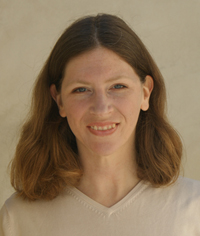Want to give crochet a try? If so, this page is a great place to find everything you’ll need to know on the topic of crochet for beginners. We’ll hook you up (pun intended!) with bunches of the best resources for learning how to crochet. You’ll find…
- Links to free crochet stitch instructions for beginners
- Easy crochet project ideas
- Suggestions for the best crochet books for beginners
- The best yarn for beginners
Let’s get started!
Get Your Crochet Project Started With a Slip Knot
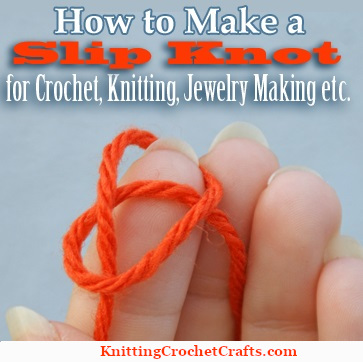
There are several different ways you can begin a crochet project. The most frequently used method is starting with a slip knot and then a starting chain.
You might already know how to make a slip knot; it’s a commonly used knot. If you don’t already know how to make a slip knot, here’s a slip knot tutorial that will teach you how to do it.
Basic Crochet Stitch Instructions for Beginners
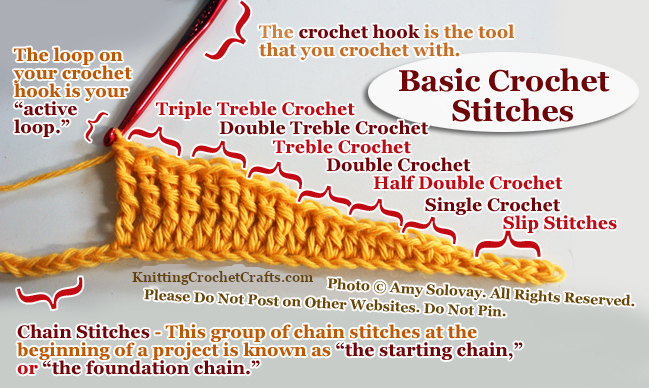
Crochet projects all have one thing in common: They’re constructed using combinations of basic crochet stitches.
- Click here for chain stitch crochet instructions. Learn this stitch first. After that, there’s no particular order that’s essential for learning your stitches — but if you learn how to do the chain stitch, the double crochet stitch and the slip stitch, you’ll be able to crochet an easy project like a basic granny square.
- Click here for single crochet instructions.
- Click here for slip stitch crochet instructions.
- Click here for half double crochet instructions.
- Click here for double crochet stitch instructions.
- Click here for treble crochet instructions.
- Click here for double treble crochet instructions.
- Click here for triple treble crochet instructions.
Best Crochet Books for Beginners
If you enjoy reading, a good beginner-level crochet instruction book or pattern book could be a worthwhile investment to consider. A crochet book isn’t an essential purchase, as there are many excellent free resources on the topic of crochet. However, it is ideal to have a well-organized book at your fingertips to refer to as you’re learning.
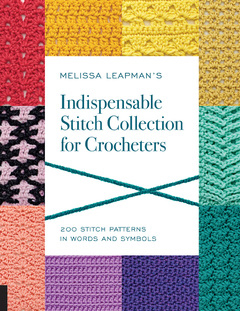
There are many worthwhile crochet books available, many of which are suitable for beginners. I’ve reviewed bunches of them; you can click here to find my picks for the best beginner’s crochet books. Pictured at right is my most-used book on the entire list — a crochet stitch dictionary by Melissa Leapman.
You won’t be a beginner forever. I recommend this book because it that can help you fast track your growth from beginner to confident crocheter. It is also a book that will remain valuable and relevant to you long after you’ve left beginner status behind. The book includes clear, helpful reference information on all the basic stitches a crochet enthusiast needs to know. It also includes bunches of designer stitch patterns, enabling you to learn how to crochet lace, cables, shell stitches, colorwork stitches, edgings and more.
- Click here to check out our book review of Melissa Leapman’s Indispensable Stitch Collection for Crocheters.
- “Click here to shop for this book at Amazon.
Best Crochet Projects for Beginners
You can do any crochet project you set your mind to doing. Crochet isn’t rocket science, and even a challenging project isn’t that hard compared to, say, giving birth, learning how to drive, learning how to write, learning how to use a computer or any other rigorously challenging thing you might have done in the past.
Having said that, there are some projects that are better than others to start off with when you’re learning how to crochet. It’s ideal to begin with an easy crochet project that has a logical, orderly set of instructions to follow. This minimizes frustration and increases the likelihood you’ll finish the project, enjoy the process and feel rewarded enough to want to continue with crocheting.
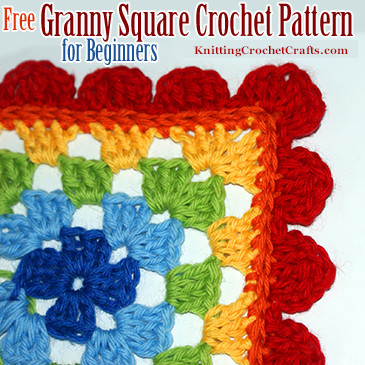
If you don’t have a strong preference for what you want to crochet first, I recommend learning how to make a granny square for your first crochet project. Granny squares progress logically from beginning to end, making them easy crochet projects that are ideal for beginners.
Granny squares are also satisfying to crochet in other ways. You can customize the colors and bunches of other details about them, and there are zillions of things you can do with them. You can turn a pile of granny squares into a blanket, a baby layette set, a hat, a sweater, a scarf, a shawl, a pillow, a bag or just about anything else you could think of.
Another reason the granny square is the ideal beginner’s crochet project: You crochet a granny square in the round; projects worked in the round tend to be easier to hold onto in the beginning stages than projects worked in rows.
To see one method for how to start a granny square or just about any crochet project in the round, check out our tutorial for how to join with a slip stitch to form a ring. This is an important crochet technique for beginners to understand.
An Easy Granny Square for Beginners
This granny square was my first crochet project as a child. I think I was six or seven years old when I learned how to make this. I’m passing the same exact pattern along to you. While there are more exciting granny square patterns available, this one is a good one to start off with because it is almost stupidly easy and it is also really versatile.
More Granny Squares:
Easy Crochet Scarf Patterns for Beginners
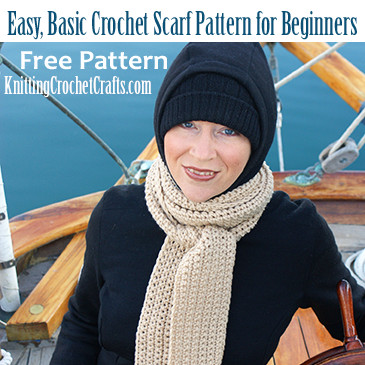
Easy, Basic Single Crochet Scarf Pattern for Beginners
This pattern is for a super scarf measuring 7 feet long. It’s a unisex scarf pattern crocheted in long, horizontal rows.
My single crochet stitch tutorial includes instructions for making another easy, beginner-friendly scarf using single crochet stitch. This scarf can be as short or long as you want it to be; it is crocheted in the vertical direction, and you can simply stop crocheting when the scarf reaches the length you find most appealing.
Easy Beginner’s Crochet Neck Warmer Pattern
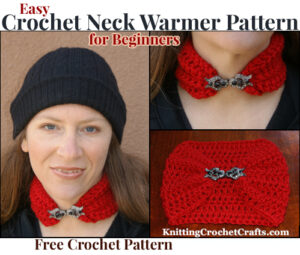
This beginner-friendly neck warmer pattern offers you a fantastic way to make a practical project while also learning or practicing your double crochet stitch. I designed this project with the holiday season in mind; it’s warm, and it’s also dressy enough to be suitable for wearing out to parties during the cold winter months.
Easy Crochet Dishcloths and Washcloths for Beginners
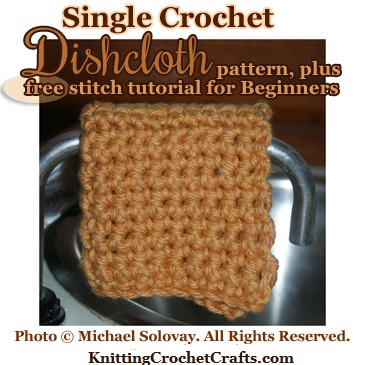
My single crochet stitch tutorial also includes instructions for making a small cloth you can use as either a dishcloth or a washcloth. I recommend making as many of these as it takes to get comfortable making single crochet stitches. If you make mistakes in the process of crocheting these, it’s no big deal; they’ll still scrub your dishes clean regardless.
An Easy Crochet Baby Hat Pattern for Beginners
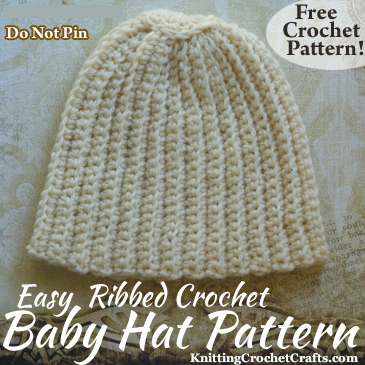
This little baby hat is super cute. If you crochet it in a neutral color like off white, it matches just about any outfit or outerwear. The design works well for baby boys and baby girls, which makes it a nice baby shower gift or charity crochet project.
An Easy Crochet Circle for Beginners
The link above takes you to a free crochet pattern for a flat, plain, easy circle shape that’s customizable. If you’re in need of a beginner-friendly crocheted circle for just about any purpose, that pattern is a good one to try.
See Also:
Easy Openwork Crochet Headband Pattern for Beginners
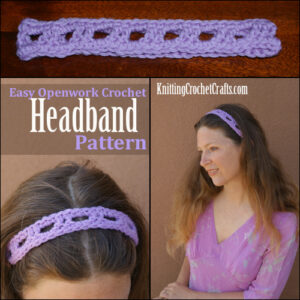
This quick, easy women’s headband uses only the basic crochet stitches, and it is a satisfying project to crochet.
Best Yarn for Beginners
For the first swatches and crochet projects you create as you learn how to crochet, it’s best to stick with using yarns that have the following characteristics:
- The yarn is smooth and evenly spun. Avoid using heavily textured yarns or furry yarns like boucle or eyelash yarn until you are crocheting confidently. It’s easier to see your stitches when you use a smooth yarn.
- The yarn is light or bright in color. Avoid using dark yarns when making your first crochet projects. It’s easier to distinguish your stitches when you work with light-colored yarns. Dark-colored yarns can cause frustration because it isn’t easy to see the stitches as you crochet.
- The yarn is thick enough to hold onto easily, but not too thick to manipulate easily. A medium weight yarn is a good choice.
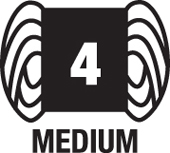
The Symbol for a Medium Weight Yarn on the Craft Yarn Council’s Standardized System of Yarn Weights
How do you recognize a “medium weight yarn”? When you shop for yarn, you might notice that some yarns include a symbol with a number on the label. You can see an example of this pictured at right. Look for yarn that’s about a size 4 on the Craft Yarn Council’s standard yarn weight system. 3s and 5s are fine too. Yarns at either extreme — extremely fine or extremely thick — can be challenging to work with and could cause you frustration as you learn how to crochet.
- The yarn is resilient, forgiving of mistakes and can be unraveled easily.
Wool is the fiber that can best meet all these characteristics. My opinion: An affordable wool yarn like Cascade 220 is the best yarn for beginners to use when learning how to crochet. Cascade 220 comes in a beautiful color palette; it’s affordable and offers an excellent value in exchange for the money you spend on it. It’s soft, resilient, easy to work with and easy to unravel if you need to fix beginner’s mistakes.
Some crochet teachers recommend acrylic yarn as being the best yarn for beginning crocheters, but I cannot in good conscience make this recommendation. Acrylic is toxic, and it poses environmental hazards.
Acrylic poisons the factory workers who manufacture it, as I found out firsthand when I worked in the textile industry. As far as I know, nobody can say with certainty whether or not acrylic poisons the people who crochet with it or wear it — but after having discussed this at length with my colleagues in the textile industry, I suspect it does. This is in part because acrylic continues to “offgas” long after its initial manufacture, and in part because the solvents used for manufacturing it can also be toxic and problematic.
Acrylic does not readily biodegrade, and there is no easy way to get rid of it once it exists. If you do decide to crochet with acrylic yarn, I suggest saving it for projects that you will want to keep forever — like classic blankets or sweaters. You’re not likely to want to hang onto your first practice crochet swatches. If they eventually find their way into a landfill, acrylic swatches won’t easily biodegrade like swatches made with a natural fiber yarn would.
If you found this page helpful, I invite you to return to this site often for more craft tutorials, project ideas and inspiration! You can make sure you keep this site on your radar by signing up for my newsletter and community at Substack. .
Basic subscriptions are free; I send out regular newsletters to let my subscribers know about new craft articles and tutorials as they are posted. I also share details about the craft projects I’m working on, and invite my readers to share their projects, too. So there is no need to feel like it’s just you, crafting all alone at home. I’d love to have you join us! You’re invited!!
By Amy Solovay
Please Visit My Ko-Fi Shop HERE to Find My Sample Sale, Destash Sale and Digital PDF Pattern Downloads for Sale.
Please Visit My Ravelry Store HERE to Find Digital PDF Pattern Downloads for Sale.
About the Author:
Amy Solovay is a real, live, human content creator and educator who holds a Bachelor of Arts degree in mathematics from Sweet Briar College; she has also earned a separate Associate of Arts degree in textile design from FIDM LA (The Fashion Institute of Design and Merchandising, Los Angeles). She is NOT a robot and does not use artificial intelligence (AI) to write book reviews or articles for this website.
Amy learned to crochet as a small child, and she still enjoys crocheting all these years later.
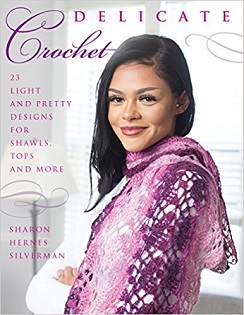
As an educator, Amy Solovay used to teach in-person college courses in trend forecasting, marketing and surface design at California Design College in Los Angeles.
If you’re interested in reading Amy’s personal blog, she invites you to visit her official website, AmySolovay.com.
References and Recommended Reading
- Breast Cancer and Acrylic Fibers
- Study Links Chemical Exposure to Breast Cancer Risk — Occupational exposure to certain chemicals while a woman is still young can increase her risk of breast cancer after menopause, researchers say.
- Postmenopausal breast cancer and occupational exposures
- From the Agency for Toxic Substances & Disease Registry Toxic Substances Portal: Acrylonitrile
- From the Environmental Protection Agency’s Website: Acrylonitrile Hazard Summary 107-13-1 — IRIS Toxicological Review of Acrylonitrile
- Why Engineering Plastics Outgas and Why You Should Care
- Center for Disease Control and Prevention: National Institute for Occupational Safety and Health / NIOSH Pocket Guide to Chemical Hazards
- Acrylonitrile Toxicity and Safety Information
- From the Federal Trade Commission’s Website: The rules and regulations under the textile fiber products identification act
- At the Environmental Protection Agency Website: An Investigation of the Biodegradability of Packaging Plastics
Textiles: Fiber to Fabric
Fifth Edition
Dr. Bernard P. Corbman
McGraw-Hill Book Company
Copyright 1975
ISBN# 0-07-013125-2
This page was last updated on 10-22-2024.
